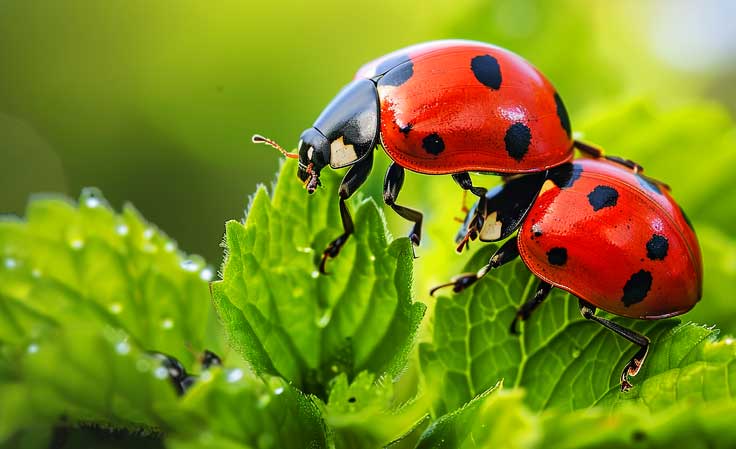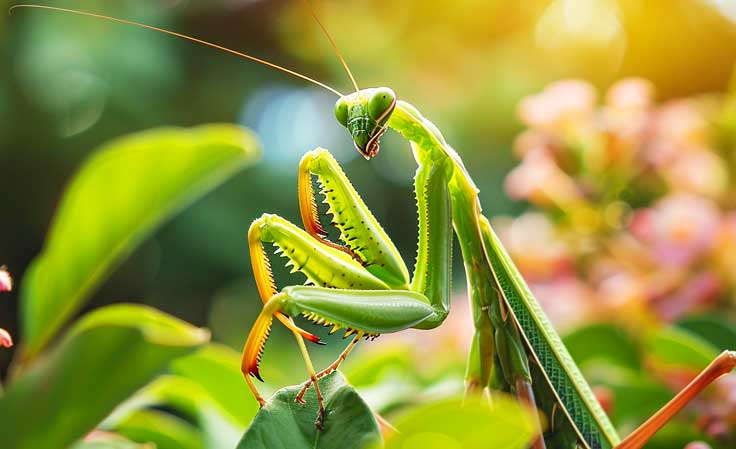Gardening is a fulfilling and rewarding activity, but it often comes with its own set of challenges, one of the most common being pests. Seriously, pests can make or break your garden.
While they are annoying, they do provide a worthy learning experience for your area and as a gardener. You may think you have the gardening ropes down, until you find webs of moths strewn about your apple tree (that happened to me last year.)
While pests can wreak havoc on your plants, resorting to harsh chemicals isn't the only solution. Natural pest management offers effective and safe alternatives to keep your garden thriving while minimizing harm to the environment and your body.
I refuse to use any pesticides in my garden for a few reasons: my health, my animals’ health (bees included,) and soil health. Pesticides have long-term effects and I don’t want to deal with those because I had a break down and couldn’t handle the pests.
I would rather have pests than deal with pesticides in my soil for years. In this comprehensive blog, we'll explore the principles of natural pest management, including beneficial insects, companion planting, homemade pest sprays, and other techniques to maintain a balanced ecosystem in your garden.
1. Find solutions
Dealing with pests in the garden can be frustrating, but it's essential to find solutions that are safe for both your plants, animals, and the garden itself.
No judgement if you do want to use pesticides, but I just think the lasting effects are not worth the return. If we wouldn’t ingest the pesticide directly, why would we want to use it in our garden when we will be ingesting what grows there?
Natural pest management focuses on utilizing biological control methods, organic practices, and eco-friendly techniques to manage pest populations while minimizing harm to beneficial insects, soil health, and overall biodiversity.
We are told that honeybee populations are on the decline, and I can’t help but wonder what role pesticides have to play in that.
2. Understanding Natural Pest Management
2.1 Importance of Natural Pest Management
Natural pest management is crucial for maintaining a healthy ecosystem in your garden. Think about your garden as a source of food that will nourish your body.
Back before grocery stores, family gardens were a primary food source along with hunting, fishing, and community trades. I think it is valuable to bring this sense of community and self-sufficiency back.
By avoiding synthetic chemicals, you can protect beneficial insects such as bees, butterflies, and ladybugs, which play a vital role in pollination and pest control.
Additionally, natural pest management methods are often more sustainable and cost-effective in the long run, reducing the need for costly chemical inputs and minimizing environmental pollution. Once you poison your soil, it is a long road to get it back to an unaltered, natural state.
3. Beneficial Insects
Beneficial insects are the unsung heroes of the garden, providing natural pest control without the need for harmful chemicals. I would research your area or talk to local gardeners to see how they feel about different insects.
Some of the insects listed here may not be beneficial to your garden or area. It is important to research before releasing any kind of insect into your garden. Here are some common beneficial insects and how they can help:

3.1 Ladybugs
Ladybugs, also known as lady beetles or ladybird beetles, are voracious predators of aphids, mites, and other soft-bodied pests. Encouraging ladybugs to inhabit your garden can help keep pest populations in check naturally.
Planting pollen and nectar-rich flowers such as daisies, fennel, and marigolds will attract ladybugs and provide them with the resources they need to thrive. Some greenhouses will sell lady bugs or you can order them in.
3.2 Lacewings
Lacewings are delicate insects with transparent wings and large, prominent eyes. They are voracious predators of aphids, caterpillars, and other garden pests.
You can attract lacewings to your garden by planting dill, cilantro, and yarrow, which serve as their favorite food sources. Additionally, providing habitat such as dense vegetation and sheltered areas will encourage lacewings to stay and breed in your garden.

3.3 Praying Mantis
Praying mantises are fascinating insects known for their distinctive appearance and predatory behavior. They feed on a wide range of insects, including beetles, grasshoppers, and moths, making them valuable allies in the garden.
You can attract praying mantises to your garden by providing ample vegetation and habitat for them to thrive, such as tall grasses, shrubs, and flowering plants. I am lucky to have a plethora of praying mantis in my surrounding area. They like to come out at night and hang out around the garden. I will see them out there waiting to catch pests!
4. Companion Planting
Companion planting involves growing certain plants together to enhance each other's growth and deter pests. This is valuable knowledge, so you can plan your garden efficiently.
I would take time to consider what you are wanting to grow and research if there are valuable companion plants to plant along with them. Some classic examples of companion plants include:
Planting aromatic herbs like basil and rosemary alongside vegetables to repel pests such as aphids and cabbage worms.
Interplanting marigolds with tomatoes to repel nematodes and attract beneficial insects such as ladybugs and lacewings. Marigolds often sellout in the beginning of the gardening season due to this reason, so make sure you are on top of sourcing your marigolds for companion planting.
Companion planting not only helps deter pests but also promotes biodiversity and improves soil health in your garden.
5. Homemade Pest Sprays
Homemade pest sprays made from natural ingredients can effectively deter pests without harming beneficial insects or plants.
Common ingredients for homemade pest sprays include garlic, neem oil, raw milk, and soap. These sprays can be applied directly to affected plants to repel pests or disrupt their life cycle. Here's a simple recipe for a homemade pest spray:
Homemade Garlic Spray:
Ingredients:
- 2 bulbs of garlic
- 1 quart of water
- 1 teaspoon of liquid soap (such as Castile soap)
Instructions:
- Crush the garlic cloves and soak them in water overnight.
- Strain the garlic-infused water and mix it with the liquid soap.
- Transfer the mixture to a spray bottle and apply it to affected plants, focusing on areas with pest infestations.
This homemade garlic spray is effective against a wide range of pests, including aphids, caterpillars, and beetles, and is safe to use on most plants. I love that garlic, a vegetable that can be grown in your garden quite easily, can be used to deter pests in your garden as well.
My pest homemade pest spray ended up being dirt that was kicked up from the road I live on. As people drove by, dirt flew into the air and coated one of my apple trees. That apple tree had no pest problems, while the apple tree that didn’t get coated with dirt, got coated with worms instead! Nature has the answer, we just have to find it.
6. Physical Barriers
Physical barriers such as row covers and netting can protect plants from pests like birds, insects, and small mammals. Row covers are particularly useful for preventing pest infestations in young seedlings and vulnerable plants.
Pests may even be your own chickens (like mine!) Last year, my chickens ended up slipping through my garden fencing and scratching up all of my melons. To say I wasn’t happy is an understatement. I was devastated. Side note, chickens will destroy your garden. Send them in at the end of the season or beginning to till the soil and drop fertilizer.
Additionally, installing barriers such as fences or cages can help keep larger pests like rabbits and deer out of your garden. Special fencing will be required for the smaller critters like rabbits (or chickens!)
7. Crop Rotation
Crop rotation is a time-tested method for reducing pest pressure and improving soil health. By rotating crops each season, you can disrupt the life cycles of pests and pathogens, preventing them from building up in the soil over time.
Pests will remember each season where they fed last season and flock to it. If they go back to your tomatoes but they are moved, they will be confused! Additionally, rotating crops helps maintain soil fertility and reduce the risk of nutrient deficiencies.
Some plants will put nutrients into the soil and some plants will deplete the soil of nutrients. This is important to know, so you can cultivate your soil.
8. Organic Mulching
Organic mulches such as straw, leaves, and grass clippings not only suppress weeds and retain moisture but also provide habitat for beneficial insects. Mulching around plants can create a barrier against pests and promote a healthy ecosystem in your garden.
Ensure that whatever mulch you are using is organic and has not been sprayed. If, for example, the straw has been sprayed, those chemicals will leech into your soil and void your organic pest control methods!
Additionally, organic mulches help improve soil structure, retain moisture, and regulate soil temperature, creating an optimal environment for plant growth.
9. Keep your garden healthy
Natural pest management offers effective and natural solutions for keeping your garden healthy and thriving. By harnessing the power of beneficial insects, companion planting, homemade pest sprays, and other eco-friendly techniques, you can maintain a balanced ecosystem while minimizing the need for harmful chemicals.
Overtime, this will save your health, your animals’ health, and your soil health. It may seem time-consuming now, but it is worth it in the long run. Whether you're a seasoned gardener or just starting, incorporating these natural pest management strategies into your gardening practices will help create a vibrant and resilient garden that flourishes year after year. The best thing to do is just start to see what works!
10. FAQs
1. Will natural pest management methods harm beneficial insects?
No, natural pest management methods are designed to target specific pests while minimizing harm to beneficial insects.
By promoting biodiversity and habitat diversity in your garden, you can create a balanced ecosystem where pests are kept in check naturally.
2. Are homemade pest sprays safe for edible crops?
Yes, most homemade pest sprays made from natural ingredients are safe to use on edible crops. However, it's essential to test the spray on a small area of the plant first and avoid spraying during hot, sunny weather to prevent leaf burn.
I sprayed some raw milk water on some plants my first season during the hot sun and it scorched the leaves. Silly me! Learn from my mistake with not coating plants during the hot portion of the day.
3. How can I attract more beneficial insects to my garden?
To attract beneficial insects to your garden, plant a diverse array of flowering plants that provide pollen and nectar throughout the growing season.
Avoid using pesticides and herbicides that can harm beneficial insects, and provide habitat such as insect hotels and brush piles for them to shelter and reproduce.
4. Can companion planting replace the need for pesticides?
While companion planting can help deter pests and reduce the need for pesticides, it may not eliminate pest problems entirely.
It's best to use companion planting as part of an integrated pest management strategy that also includes other natural pest control methods.
5. How can I prevent pests from becoming resistant to natural pest management methods?
To prevent pests from becoming resistant to natural pest management methods, it's essential to use a variety of strategies and rotate them regularly.
This prevents pests from adapting to any single control method and helps maintain its effectiveness over time. Rotation, natural pest sprays, and companion planting are all examples of strategies you can use together.

